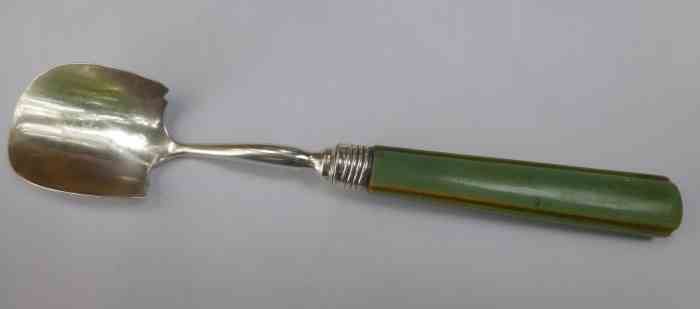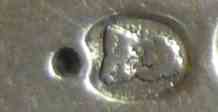
ASSOCIATION OF SMALL COLLECTORS OF ANTIQUE SILVER
ASCAS
| article # 204 |
|
|
|
|
(click on photos to enlarge image)THE ELEVEN O' CLOCK CLUBA particularly interesting conundrum was tabled by Tony Dove, a luminary and veteran of these meetings. May I immediately apologise for any deficiency in the photography. It was undertaken under difficult circumstances - a pocket camera, a crowded table littered with half full cups, busily criss-crossed by silver objects and competing discussions. The plain reverse of an A4 sheet (listing the Silver Spoon club's spoon auction results on the other side) was pressed into service as a photographic backcloth. You will see that the item is a cheese scoop with a green stained ivory handle. You will also see it has the marks for Samuel Pemberton, Birmingham 1812. It is arguable that it could be the earlier Pemberton mark, validating a possible date of 1786, but such a view, which I'm not inclined to, does not affect the overall discussion. But wait! There is something missing! There is no duty mark. Why? Never struck? Hidden? Erased? Only a keen eye detects that there are the traces of one positioned at twelve o'clock. Just where one might expect it. This is just visible in the photograph. It is not rubbed or erased, but flooded to disguise it. That is, filled with solder, and polished off to make a smooth finish and disguise. So why on earth would this have been done? More keen eyes are required to detect that there are two further very small marks on the shank. The first looks very like it is part of the French anvil mark or "bigorne" which counters a punch mark directly applied opposite. There is indeed another mark just so positioned on the other side of the shank, adding weight to the French connection. However the precise nature of the second mark is difficult to determine but still very plausible. More so in reality than the awkwardly captured image suggests (refer to apologies above!). If the second batch of marks is indeed French, then we would certainly expect a cancellation of the duty mark to go with the refund of the duty which would apply to items exported. The mark is cancelled to prevent further or repeated refund claims. But his is normally done by punching with a dot to deface the image or at least impact upon the cartouche. Not by flooding and polishing, which is in any case a far more complex and involved process. My first question is "would you have spotted all this if you were unprompted??!!" The second question of "why was it done", may take a bit longer to answer authoritatively. Speculation is rife, but no doubt there will be much research and those in the eleven o'clock club will come up with a cogent explanation or some valid possibilities. Or perhaps someone from the Australian Silver Society or ASCAS Association? My thanks to Tony Dove and the members of (in real terms) the "ten thirty" club.
|





